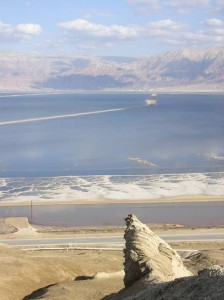Research presented by Earth Institute scientists at the 2011 American Geophysical Union fall conference in San Francisco generated a lot of attention from the media. Much of it came from a press conference held to discuss findings by Steven L. Goldstein from the Lamont-Doherty Earth Observatory and colleagues on the potential for future drying up of the Dead Sea.
Their work on core samples pulled from the seafloor suggests the sea has completely dried up in the distant past and holds implications for the people living around the Dead Sea who rely on it as a vital water supply. Chief science writer Kevin Krajick has collected some of the stories:
Bible Accounts Supported by Dead Sea Record?
National Geographic News – Dec. 9, 2011
Drought—Past and Future
Science Today – Dec. 9, 2011
Dead Sea Sediments May Deepen Understanding of Biblical Events
Discovery News – Dec. 8, 2011
Dead Sea Dried Up in Past
Science – Dec. 7, 2011
The Date the Dead Sea Died
Telegraph (London) – Dec. 6, 2011
The Dead (and Departed) Sea
Nature – Dec. 5, 2011
Cores Reveal When Dead Sea ‘Died’
BBC News – Dec. 5, 2011
After It ‘Died’ Once, Will Dead Sea Die Again?
CBS News – Dec. 5, 2011
Also covered at the conference were studies of past droughts affecting the Maya civilization and northeast United States (Ben Cook and Dorothy Peteet of Lamont Doherty/Goddard Institute for Space Studies); and a discussion of earth’s past temperatures by James Hansen (GISS).
You can read about some of the other research, from ocean acidification to studies of earth’s deep interior, by selecting the “American Geophysical Union” tag on the State of the Planet blog.
Some of the other stories that have appeared in various media:
The Maya Caused a Drought?
Le Monde – Dec 10, 2011
Evidence mounts that Maya did themselves in through deforestation
Mongabay.com – Dec 8, 2011
Earth Likely to Become Increasingly Hostile to Agriculture
Scientific American – Dec. 7, 2011
2-degree global warming limit is a ‘prescription for disaster,’ says Hansen
Nature.com (blog) – Dec 8, 2011
New Perils Seen to Even Modest Warming
The Daily Climate – Dec. 5, 2011
US to Help Bangladesh Study Earthquake Risks
South Asian News Agency (SANA) – Dec 9, 2011
Story on work of Lamont-Doherty scientists led by Michael Steckler
Pinot Noir Grapes Reveal 700-Year Climate Record
Inside Science – Dec. 7, 2011
Story on work of Lamont scientist Yves Tourre
Doubling Virtual CO2 Provides Insight Into Atmospheric Reactions
AGU Blogosphere – Dec. 7, 2011
Story on modeling study by Lamont-Doherty scientist Yutian Wu

